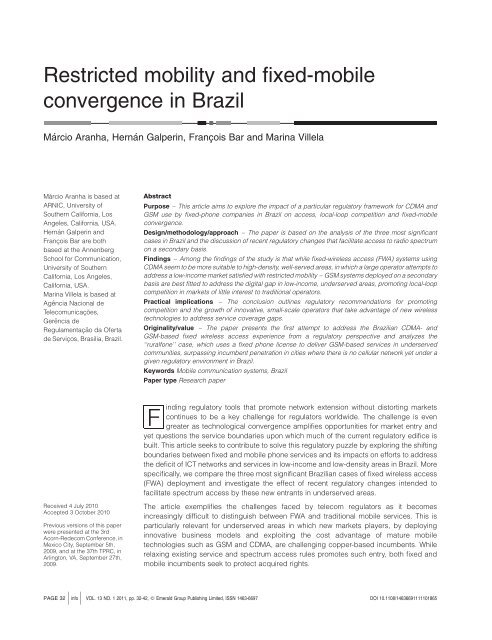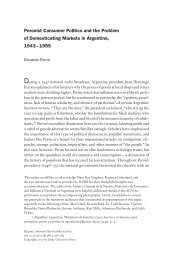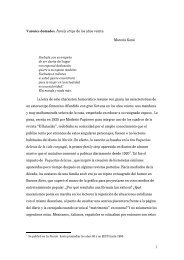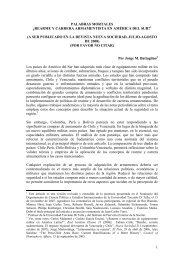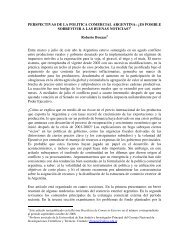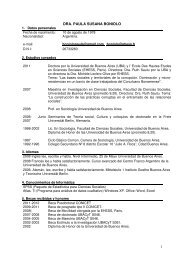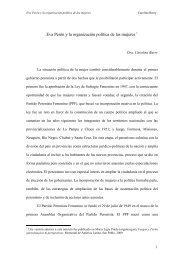Restricted mobility and fixed-mobile convergence in Brazil
Restricted mobility and fixed-mobile convergence in Brazil
Restricted mobility and fixed-mobile convergence in Brazil
You also want an ePaper? Increase the reach of your titles
YUMPU automatically turns print PDFs into web optimized ePapers that Google loves.
<strong>Restricted</strong> <strong>mobility</strong> <strong>and</strong> <strong>fixed</strong>-<strong>mobile</strong><br />
<strong>convergence</strong> <strong>in</strong> <strong>Brazil</strong><br />
Márcio Aranha, Hernán Galper<strong>in</strong>, François Bar <strong>and</strong> Mar<strong>in</strong>a Villela<br />
Márcio Aranha is based at<br />
ARNIC, University of<br />
Southern California, Los<br />
Angeles, California, USA.<br />
Hernán Galper<strong>in</strong> <strong>and</strong><br />
François Bar are both<br />
based at the Annenberg<br />
School for Communication,<br />
University of Southern<br />
California, Los Angeles,<br />
California, USA.<br />
Mar<strong>in</strong>a Villela is based at<br />
Agência Nacional de<br />
Telecomunicações,<br />
Gerência de<br />
Regulamentação da Oferta<br />
de Serviços, Brasilia, <strong>Brazil</strong>.<br />
Received 4 July 2010<br />
Accepted 3 October 2010<br />
Previous versions of this paper<br />
were presented at the 3rd<br />
Acorn-Redecom Conference, <strong>in</strong><br />
Mexico City, September 5th,<br />
2009, <strong>and</strong> at the 37th TPRC, <strong>in</strong><br />
Arl<strong>in</strong>gton, VA, September 27th,<br />
2009.<br />
PAGE 32 j <strong>in</strong>fo j<br />
Abstract<br />
Purpose – This article aims to explore the impact of a particular regulatory framework for CDMA <strong>and</strong><br />
GSM use by <strong>fixed</strong>-phone companies <strong>in</strong> <strong>Brazil</strong> on access, local-loop competition <strong>and</strong> <strong>fixed</strong>-<strong>mobile</strong><br />
<strong>convergence</strong>.<br />
Design/methodology/approach – The paper is based on the analysis of the three most significant<br />
cases <strong>in</strong> <strong>Brazil</strong> <strong>and</strong> the discussion of recent regulatory changes that facilitate access to radio spectrum<br />
on a secondary basis.<br />
F<strong>in</strong>d<strong>in</strong>gs – Among the f<strong>in</strong>d<strong>in</strong>gs of the study is that while <strong>fixed</strong>-wireless access (FWA) systems us<strong>in</strong>g<br />
CDMA seem to be more suitable to high-density, well-served areas, <strong>in</strong> which a large operator attempts to<br />
address a low-<strong>in</strong>come market satisfied with restricted <strong>mobility</strong> – GSM systems deployed on a secondary<br />
basis are best fitted to address the digital gap <strong>in</strong> low-<strong>in</strong>come, underserved areas, promot<strong>in</strong>g local-loop<br />
competition <strong>in</strong> markets of little <strong>in</strong>terest to traditional operators.<br />
Practical implications – The conclusion outl<strong>in</strong>es regulatory recommendations for promot<strong>in</strong>g<br />
competition <strong>and</strong> the growth of <strong>in</strong>novative, small-scale operators that take advantage of new wireless<br />
technologies to address service coverage gaps.<br />
Orig<strong>in</strong>ality/value – The paper presents the first attempt to address the <strong>Brazil</strong>ian CDMA- <strong>and</strong><br />
GSM-based <strong>fixed</strong> wireless access experience from a regulatory perspective <strong>and</strong> analyzes the<br />
‘‘ruralfone’’ case, which uses a <strong>fixed</strong> phone license to deliver GSM-based services <strong>in</strong> underserved<br />
communities, surpass<strong>in</strong>g <strong>in</strong>cumbent penetration <strong>in</strong> cities where there is no cellular network yet under a<br />
given regulatory environment <strong>in</strong> <strong>Brazil</strong>.<br />
Keywords Mobile communication systems, <strong>Brazil</strong><br />
Paper type Research paper<br />
F<br />
<strong>in</strong>d<strong>in</strong>g regulatory tools that promote network extension without distort<strong>in</strong>g markets<br />
cont<strong>in</strong>ues to be a key challenge for regulators worldwide. The challenge is even<br />
greater as technological <strong>convergence</strong> amplifies opportunities for market entry <strong>and</strong><br />
yet questions the service boundaries upon which much of the current regulatory edifice is<br />
built. This article seeks to contribute to solve this regulatory puzzle by explor<strong>in</strong>g the shift<strong>in</strong>g<br />
boundaries between <strong>fixed</strong> <strong>and</strong> <strong>mobile</strong> phone services <strong>and</strong> its impacts on efforts to address<br />
the deficit of ICT networks <strong>and</strong> services <strong>in</strong> low-<strong>in</strong>come <strong>and</strong> low-density areas <strong>in</strong> <strong>Brazil</strong>. More<br />
specifically, we compare the three most significant <strong>Brazil</strong>ian cases of <strong>fixed</strong> wireless access<br />
(FWA) deployment <strong>and</strong> <strong>in</strong>vestigate the effect of recent regulatory changes <strong>in</strong>tended to<br />
facilitate spectrum access by these new entrants <strong>in</strong> underserved areas.<br />
The article exemplifies the challenges faced by telecom regulators as it becomes<br />
<strong>in</strong>creas<strong>in</strong>gly difficult to dist<strong>in</strong>guish between FWA <strong>and</strong> traditional <strong>mobile</strong> services. This is<br />
particularly relevant for underserved areas <strong>in</strong> which new markets players, by deploy<strong>in</strong>g<br />
<strong>in</strong>novative bus<strong>in</strong>ess models <strong>and</strong> exploit<strong>in</strong>g the cost advantage of mature <strong>mobile</strong><br />
technologies such as GSM <strong>and</strong> CDMA, are challeng<strong>in</strong>g copper-based <strong>in</strong>cumbents. While<br />
relax<strong>in</strong>g exist<strong>in</strong>g service <strong>and</strong> spectrum access rules promotes such entry, both <strong>fixed</strong> <strong>and</strong><br />
<strong>mobile</strong> <strong>in</strong>cumbents seek to protect acquired rights.<br />
VOL. 13 NO. 1 2011, pp. 32-42, Q Emerald Group Publish<strong>in</strong>g Limited, ISSN 1463-6697 DOI 10.1108/14636691111101865
The article is organized <strong>in</strong> four ma<strong>in</strong> parts. The first provides a brief background on the<br />
evolution of the telecommunications sector <strong>in</strong> <strong>Brazil</strong>, while the second delves <strong>in</strong>to the legal<br />
framework for <strong>fixed</strong> <strong>and</strong> <strong>mobile</strong> telephone services <strong>in</strong> <strong>Brazil</strong>, with particular attention to the<br />
def<strong>in</strong>ition of <strong>fixed</strong> wireless access (FWA) <strong>and</strong> ‘‘restricted <strong>mobility</strong>’’. The third part exam<strong>in</strong>es<br />
how FWA/WLL <strong>and</strong> GSM networks have been deployed by <strong>fixed</strong> phone entrants <strong>in</strong> <strong>Brazil</strong>,<br />
focus<strong>in</strong>g on three cases: Vésper Portátil, Embratel Livre <strong>and</strong> Local or Ruralfone. In the<br />
follow<strong>in</strong>g part, the article addresses the regulatory tensions surround<strong>in</strong>g the def<strong>in</strong>ition of<br />
<strong>fixed</strong> <strong>and</strong> <strong>mobile</strong> services, discuss<strong>in</strong>g recent changes <strong>in</strong> equipment rules <strong>and</strong> regulatory<br />
<strong>in</strong>itiatives seek<strong>in</strong>g to promote entry by small-scale operators <strong>in</strong> low-<strong>in</strong>come <strong>and</strong> low-density<br />
areas.<br />
Prelude to <strong>fixed</strong>-<strong>mobile</strong> <strong>convergence</strong> <strong>in</strong> <strong>Brazil</strong><br />
The telecommunication reforms <strong>in</strong>itiated <strong>in</strong> <strong>Brazil</strong> <strong>in</strong> 1985 has had two def<strong>in</strong><strong>in</strong>g moments:<br />
1. The creation of an <strong>in</strong>dependent regulator (Agência Nacional de Telecomunicações, or<br />
Anatel) <strong>in</strong> 1998.<br />
2. The privatization of the Telebrás System, a state owned hold<strong>in</strong>g which was the largest<br />
Lat<strong>in</strong> American telephone company at that time (Siqueira, 1993; Melo et al., 2005).<br />
Up until 1998, 91 percent of the <strong>Brazil</strong>ian telephone l<strong>in</strong>es belonged to the state owned<br />
Telebrás hold<strong>in</strong>g (Padilha, 2001, p. 26). This scenario shifted drastically after privatization,<br />
as the country was divided <strong>in</strong>to four areas for <strong>in</strong>cumbents of the <strong>fixed</strong> switched telephone<br />
service (STFC) <strong>and</strong> ten areas for <strong>in</strong>cumbents of the emerg<strong>in</strong>g cellular <strong>mobile</strong> service (SMC),<br />
later converted to personal <strong>mobile</strong> service (SMP)[1].<br />
Cellular services played an important role <strong>in</strong> the <strong>Brazil</strong>ian regulatory reforms undertaken <strong>in</strong><br />
the mid 1990s. After seven years of judicial battles, a constitutional amendment was passed<br />
<strong>in</strong> 1995 allow<strong>in</strong>g private enterprises full rights to provide <strong>mobile</strong> telephony services. In<br />
practical terms, <strong>mobile</strong> <strong>and</strong> <strong>fixed</strong> telephone services would be clearly separated <strong>in</strong> 1998,<br />
when the 26 state-owned companies were f<strong>in</strong>ally assembled under three hold<strong>in</strong>gs for <strong>fixed</strong><br />
telephone services <strong>and</strong> eight hold<strong>in</strong>gs for <strong>mobile</strong> telephone services.<br />
S<strong>in</strong>ce then, <strong>Brazil</strong>ian telecommunication regulation has been characterized by an<br />
<strong>in</strong>cremental separation between <strong>fixed</strong> <strong>and</strong> <strong>mobile</strong> telephone services. To beg<strong>in</strong> with, only<br />
<strong>fixed</strong> services are, strictly speak<strong>in</strong>g, subjected to a public service regime. Furthermore,<br />
<strong>mobile</strong> operators are allowed to provide broadb<strong>and</strong> service under the terms of their<br />
current license, while <strong>fixed</strong> operators require an additional license from Anatel as the<br />
service is restricted to data rates of 64 Kbps. In short, favorable tariff <strong>and</strong> service rules,<br />
coupled with lower deployment costs, resulted <strong>in</strong> the rapid expansion of <strong>mobile</strong> services<br />
<strong>in</strong> <strong>Brazil</strong>, while <strong>fixed</strong> services stagnated (Haugen et al., 1994; Männistö <strong>and</strong> Tuisku, 1994;<br />
ITU, 2008).<br />
In 2008, Anatel conducted a technical study (Anatel, 2008) <strong>in</strong> order to establish a<br />
ten-year market outlook <strong>and</strong> propose actions to update the regulatory framework, with<br />
particular attention to accelerat<strong>in</strong>g the diffusion of broadb<strong>and</strong> access services <strong>and</strong><br />
reduc<strong>in</strong>g access barriers <strong>in</strong> high-cost <strong>and</strong> low-<strong>in</strong>come areas. This study became the<br />
basis for the enactment of the general plan of telecommunication regulation update<br />
(PGR). The plan identified <strong>mobile</strong> networks as the most appropriate alternative to<br />
accelerate network deployment, promote the provision of converged services <strong>and</strong><br />
consolidate competition <strong>in</strong> the sector (Anatel, 2008, p. 133). A key concern for Anatel was<br />
to reverse the <strong>in</strong>creas<strong>in</strong>g service gaps between wealthy high-density areas <strong>and</strong><br />
low-density, low-<strong>in</strong>come ones.<br />
Promot<strong>in</strong>g the deployment of FWA was perceived as an alternative to reverse the stagnation<br />
of <strong>fixed</strong> services <strong>and</strong> promote deployment <strong>in</strong> underserved areas (Tr<strong>in</strong>kwon, 1997). The<br />
deployment of FWA/WLL networks started <strong>in</strong> <strong>Brazil</strong> <strong>in</strong> 2001, when Anatel established rules<br />
for the use of the so-called user portable term<strong>in</strong>al equipment (<strong>in</strong> other words, <strong>mobile</strong><br />
h<strong>and</strong>sets) <strong>in</strong> <strong>fixed</strong> phone networks. Currently, <strong>fixed</strong> wireless access (FWA) is def<strong>in</strong>ed <strong>in</strong><br />
<strong>Brazil</strong> as a wireless access application utilized by <strong>fixed</strong> telephony operators for local loop<br />
VOL. 13 NO. 1 2011 j<strong>in</strong>foj PAGE 33
Table I Case studies: key characteristics<br />
connections, or wireless local loop (WLL). There are no precise limits for FWA term<strong>in</strong>al<br />
<strong>mobility</strong>, or possible enforcement methods to ensure that term<strong>in</strong>als are conf<strong>in</strong>ed to a<br />
predef<strong>in</strong>ed area of <strong>mobility</strong>, s<strong>in</strong>ce real estate dimensions vary considerably. Besides,<br />
Anatel’s efforts to address this issue have also revealed that there is a right to <strong>mobility</strong><br />
pursuant to STFC regulation.<br />
After regulat<strong>in</strong>g the use of portable term<strong>in</strong>al equipment for <strong>fixed</strong> networks <strong>in</strong> 2001, Anatel’s<br />
board of directors ruled on radio frequency usage, establish<strong>in</strong>g that some radio frequencies<br />
assigned to <strong>mobile</strong> services (between 171-1755 MHz <strong>and</strong> 1805-1850 MHz) may be used by<br />
STFC operators on a secondary basis. This was re<strong>in</strong>forced by another resolution <strong>in</strong> 2006,<br />
which attributed, on a secondary basis, more SMP frequencies to STFC wireless<br />
applications. SMP radio frequency assignment to STFC on a secondary basis has had an<br />
apparent effect on the <strong>in</strong>frastructure cost of new entrants. Secondary use of frequency<br />
b<strong>and</strong>s spares <strong>fixed</strong> operators from spectrum acquisition costs <strong>and</strong> authorization fees, while<br />
enabl<strong>in</strong>g them to take advantage of economies of scale <strong>in</strong> mature <strong>mobile</strong> technologies. As<br />
described by Weiss (2006), secondary use plays an important role as a technical, bus<strong>in</strong>ess<br />
<strong>and</strong> regulatory mechanism for more effective spectrum management <strong>and</strong> its use depends<br />
upon a temporal <strong>and</strong> geographic function.<br />
The evolution of the <strong>Brazil</strong>ian telecommunication legal framework has therefore resulted <strong>in</strong> a<br />
fertile environment for the <strong>convergence</strong> of <strong>fixed</strong> <strong>and</strong> <strong>mobile</strong> services, s<strong>in</strong>ce the regulator has<br />
promoted the use of <strong>mobile</strong> telephony spectrum by new <strong>fixed</strong>-service entrants on secondary<br />
basis <strong>and</strong> authorized portable term<strong>in</strong>al equipment for use by STFC providers. As we shall<br />
discuss below, this has promoted entry by <strong>in</strong>novative competitors <strong>in</strong> underserved areas or<br />
for underserved groups (such as the elderly), though at the same time such changes have<br />
led to regulatory tensions that cast a cloud over the new breed of hybrid <strong>fixed</strong>-<strong>mobile</strong> market<br />
players.<br />
Mobility on <strong>fixed</strong> services: case studies<br />
The three case studies discussed <strong>in</strong> this section reveal the key regulatory challenges raised<br />
by <strong>fixed</strong>-<strong>mobile</strong> <strong>convergence</strong> <strong>in</strong> the context of efforts to <strong>in</strong>crease competition <strong>and</strong> exp<strong>and</strong><br />
service offer<strong>in</strong>gs for underserved customers. They will be here<strong>in</strong> referred to by their<br />
commercial names: Vésper Portátil; Embratel Livre; <strong>and</strong> Local. Table I summarizes the ma<strong>in</strong><br />
characteristics of each of these services.<br />
Vésper Portátil/Embratel Livre Local<br />
Bus<strong>in</strong>ess model Low-<strong>in</strong>come customers <strong>in</strong> urban areas<br />
Underserved areas<br />
Subscription-less service<br />
Small-scale telecom operator<br />
Low-cost deployment<br />
Local entrepreneurship<br />
H<strong>and</strong>set economies of scale<br />
Low-cost deployment<br />
H<strong>and</strong>set economies of scale<br />
Spectrum Primary spectrum authorization (STFC<br />
Secondary spectrum use (SMP frequencies)<br />
frequencies)<br />
Local: 1835-1838 MHz <strong>and</strong> 1740 MHz<br />
Vésper Portátil: 1935 MHz<br />
(Radio frequencies not yet assigned for SMP<br />
Embratel Livre: 1975 to 1990 MHz <strong>and</strong> 1895 to<br />
providers on a primary basis <strong>in</strong> the areas where<br />
1910 MHz<br />
local operates)<br />
Technology CDMA GSM<br />
License Service license: STFC<br />
Service license: STFC<br />
Radio frequency license: WLL radio frequency<br />
Radio frequency license: secondary use of SMP<br />
licenses<br />
frequencies<br />
Regions All codes <strong>in</strong> Regions 1, 2 <strong>and</strong> 3 (national<br />
coverage)<br />
Codes 85 to 88 <strong>in</strong> Region 1 a<br />
Subscribers 2.5 million (December 2009 estimate) 6,000 subscribers (December 2008)<br />
Note: a Area codes correspond<strong>in</strong>g to the <strong>Brazil</strong>ian states of Ceará, Pernambuco <strong>and</strong> northern Piauí<br />
PAGE 34j <strong>in</strong>foj VOL. 13 NO. 1 2011
Vésper Portátil<br />
The first commercial use of FWA/WLL <strong>in</strong> <strong>Brazil</strong> dates back to 1999, when local carrier<br />
Telemar provided STFC with FWA/WLL <strong>in</strong> the city of Parati <strong>in</strong> the state of Rio de Janeiro.<br />
Shortly after, Bell Canada, Velocom <strong>and</strong> Qualcomm created Vésper, a jo<strong>in</strong>t venture aimed at<br />
provid<strong>in</strong>g STFC service us<strong>in</strong>g wireless technologies <strong>and</strong> compet<strong>in</strong>g with <strong>fixed</strong> <strong>in</strong>cumbents<br />
Telefônica <strong>and</strong> Telemar <strong>in</strong> the key markets of Sao Paulo, Rio de Janeiro, M<strong>in</strong>as Gerais <strong>and</strong> 14<br />
others. The arrival of Vésper was highly significant for a variety of reasons. On the one h<strong>and</strong>,<br />
it was the first attempt by a new entrant to compete with local <strong>in</strong>cumbents <strong>in</strong> mature markets<br />
us<strong>in</strong>g FWA/WLL for last-mile access. This also represented a test for the newly established<br />
legal framework that attempted to promote competition through local-loop unbundl<strong>in</strong>g <strong>and</strong><br />
asymmetric regulation between <strong>in</strong>cumbents <strong>and</strong> new entrants. Lastly, as the regulatory<br />
battle moved to the courts, the judicial outcome was perceived as a key signal about the role<br />
that the judiciary would play <strong>in</strong> the new <strong>Brazil</strong>ian telecom regulatory environment.<br />
Bell Canada, Velocom <strong>and</strong> Qualcomm <strong>in</strong>stituted Vésper to provide STFC <strong>in</strong> the state of Sao<br />
Paulo <strong>and</strong> other 16 states <strong>in</strong> <strong>Brazil</strong>, <strong>in</strong>itially compet<strong>in</strong>g with two local carriers for <strong>fixed</strong> phone<br />
services: Telefônica, <strong>in</strong> the state of Sao Paulo, correspondent to the area with highest <strong>in</strong>come<br />
<strong>and</strong> population density <strong>in</strong> <strong>Brazil</strong>, that is Region 3 of the General Plan of Concessions (PGO);<br />
<strong>and</strong> Telemar, <strong>in</strong> the states of Rio de Janeiro, M<strong>in</strong>as Gerais, Espírito Santo, Bahia, Sergipe,<br />
Alagoas, Pernambuco, Paraíba, Rio Gr<strong>and</strong>e do Norte, Ceará, Piauí, Maranhão, Pará,<br />
Amapá, Amazonas <strong>and</strong> Roraima, correspondent to Region 1 of the PGO, which<br />
encompasses the North <strong>and</strong> East regions of the <strong>Brazil</strong>ian territory.<br />
The use of FWA/WLL by Vésper was approved by Anatel’s Resolution 271 of August 6, 2001,<br />
which authorized the use of cellular h<strong>and</strong>sets for FWA/WLL applications as a substitute for<br />
STFC customer premises equipment. Vésper decided to deploy term<strong>in</strong>als embedded with<br />
CDMA IS-95 technology that worked at 14.4 Kbps. The network admitted roam<strong>in</strong>g <strong>and</strong><br />
h<strong>and</strong>off-h<strong>and</strong>over. Vésper also offered customers the ability to orig<strong>in</strong>ate calls <strong>in</strong> a radius up<br />
to 9 km around the subscriber’s home or office, while the <strong>mobility</strong> area for a call <strong>in</strong> progress<br />
was equivalent to the city of Sao Paulo area <strong>and</strong> two nearby cities.<br />
By allow<strong>in</strong>g customers a certa<strong>in</strong> degree of <strong>mobility</strong>, Vésper was test<strong>in</strong>g the limits of the<br />
established separation between <strong>fixed</strong> <strong>and</strong> <strong>mobile</strong> services. As expected, <strong>mobile</strong> operators<br />
were the first to raise concerns about the ability of STFC licensees to compete <strong>in</strong> a market<br />
reserved for SMP licensees. In 2001, Telemar <strong>and</strong> Telemig filed adm<strong>in</strong>istrative compla<strong>in</strong>ts<br />
aga<strong>in</strong>st Vésper with Anatel, which <strong>in</strong> its first decision issued <strong>in</strong> August 2002 suspended the<br />
deployment of Vésper’s services. The suspension was revoked a month later, when the<br />
regulator established that Vésper’s services should be limited to so-called restricted <strong>mobility</strong><br />
areas. Still, Anatel prevented any new deployment before it could certify that the operator<br />
complied with the above restrictions.<br />
At the same time, <strong>mobile</strong> operators also filed suit <strong>in</strong> the state of Rio de Janeiro, argu<strong>in</strong>g that<br />
Vésper was emulat<strong>in</strong>g <strong>mobile</strong> services restricted by federal regulation to SMP licensees. The<br />
pla<strong>in</strong>tiffs’ argument was based on the fact that <strong>fixed</strong> services bounded users to a specific<br />
home or office address, <strong>and</strong> asked for a judicial annulment of Anatel’s rules allow<strong>in</strong>g STFC<br />
licensees to deploy wireless personal voice <strong>and</strong> data communications term<strong>in</strong>als. In<br />
September 2004, the Superior Court of Justice recognized state jurisdiction over the issue.<br />
In August 2007, the Rio de Janeiro Court of Appeals concluded that Vésper did not violate<br />
STFC regulations. Accord<strong>in</strong>g to the Court, <strong>mobile</strong> operators failed to prove that the mere<br />
employment of <strong>mobile</strong> devices violated federal rules that bound <strong>fixed</strong> telephony services to a<br />
specific address, especially due to the chang<strong>in</strong>g nature of customers’ real estate<br />
dimensions. On December 2008, the Superior Court of Justice denied an appeal by <strong>mobile</strong><br />
operators, confirm<strong>in</strong>g the rul<strong>in</strong>g that the mere technical possibility of h<strong>and</strong>set <strong>mobility</strong><br />
beyond the geographic area of the client’s home or office did not violate the terms of STFC<br />
licenses.<br />
The Vésper case reveals a regulatory l<strong>and</strong>scape <strong>in</strong> which the regulator struggles to draw the<br />
l<strong>in</strong>e between <strong>fixed</strong> <strong>and</strong> <strong>mobile</strong> services, which led to a protracted regulatory battle <strong>in</strong> the<br />
courts. While the judiciary process ended by <strong>and</strong> large <strong>in</strong> a victory for Vésper, the lengthy<br />
VOL. 13 NO. 1 2011 j<strong>in</strong>foj PAGE 35
PAGE 36j <strong>in</strong>foj VOL. 13 NO. 1 2011<br />
dispute hardly provided an enabl<strong>in</strong>g environment for the growth Vésper <strong>and</strong> other new<br />
market entrants bett<strong>in</strong>g on the use of low-cost wireless technologies to challenge<br />
<strong>in</strong>cumbents.<br />
Embratel<br />
The second case of <strong>in</strong>terest is Embratel’s wireless local loop system. Until recently, Embratel<br />
carried out a role <strong>in</strong> the <strong>Brazil</strong>ian telecommunication scenario very similar to that played by<br />
AT&T after the Bell System divestiture as a long-distance exclusive franchisee. Telebrás<br />
System history mimicked Bell System rise <strong>and</strong> fall described <strong>in</strong> Huber et al. (1999) pass<strong>in</strong>g<br />
through periods of regulated monopoly, quarant<strong>in</strong>ed exclusive franchises, duopoly system<br />
(Piragibe, 2001), <strong>and</strong> f<strong>in</strong>ally regulatory <strong>in</strong>centives towards competition.<br />
Until 1999, Embratel was the only provider of <strong>in</strong>ternational <strong>and</strong> <strong>in</strong>ter-regional calls <strong>in</strong> <strong>Brazil</strong>.<br />
The period of duopoly system was then extended until 2002, when previous regulation<br />
prevent<strong>in</strong>g <strong>in</strong>cumbents to compete with each other was f<strong>in</strong>ally overcome. Curiously, the<br />
<strong>Brazil</strong>ian equivalent of AT&T, then a state owned enterprise, was acquired on July 1998 by a<br />
subsidiary of MCI WorlCom, Startel Participações Ltda, which bought 19.26 percent of<br />
Embratel’s total shares. After that year of 2002, most of telephone <strong>in</strong>cumbents, <strong>in</strong>clud<strong>in</strong>g<br />
Embratel, were f<strong>in</strong>ally granted to compete <strong>in</strong> other regions of the General Concessions Plan<br />
as competitive local exchange <strong>and</strong> long-distance carriers <strong>in</strong> the private regime. For that<br />
reason, Embratel <strong>in</strong>itiated its local loop services only on December 2002 compet<strong>in</strong>g <strong>in</strong>side<br />
the stronghold of well-established <strong>in</strong>cumbents, such as Telefônica, Telemar <strong>and</strong> Brasil<br />
Telecom.<br />
Not surpris<strong>in</strong>gly, Embratel’s bus<strong>in</strong>ess model headed toward FWA/WLL facilities, apply<strong>in</strong>g<br />
them on its local telephony service over <strong>fixed</strong>-<strong>mobile</strong> network. This service called Embratel<br />
Livre is officially referred to as a former FWA/WLL service from Vésper, which was acquired<br />
by Embratel on December 2003, although Embratel’s experience with FWA/WLL started<br />
earlier, <strong>in</strong> 2002, as a subscriptionless service (Embratel, 2007) <strong>in</strong> two cities – Fortaleza <strong>and</strong><br />
Recife. On May 8, 2002, Embratel certified the anticipation of its univesalization goals <strong>and</strong><br />
applied for local STFC permits <strong>in</strong> the rema<strong>in</strong><strong>in</strong>g three regions of the General Concessions<br />
Plan. On August, 2002, Embratel was then authorized to provide local <strong>fixed</strong> phone services<br />
<strong>in</strong> all regions of the <strong>Brazil</strong>ian territory becom<strong>in</strong>g the first national competitive local exchange<br />
carrier after the privatization of the Telebrás System. Embratel started provid<strong>in</strong>g local<br />
services on December, 2002.<br />
Embratel Livre, VipL<strong>in</strong>e <strong>and</strong> NetFone services were designed by Embratel to penetrate <strong>in</strong> the<br />
local exchange carrier market, but only Embratel Livre aimed at low-<strong>in</strong>come users. This<br />
service plan resembled Vésper Portátil <strong>in</strong> many ways such as the ability of orig<strong>in</strong>at<strong>in</strong>g calls <strong>in</strong><br />
a radius of up to 3.5 km around customers’ home or office (Capella, 2008) <strong>and</strong> the ability of<br />
perform<strong>in</strong>g roam<strong>in</strong>g <strong>and</strong> h<strong>and</strong>off-h<strong>and</strong>over us<strong>in</strong>g CDMA technology. After Vésper<br />
acquisition by Embratel <strong>in</strong> 2003, their FWA/WLL services were then gathered under the<br />
expression Embratel Livre, which has been reported as the only Embratel’s strategy for<br />
<strong>in</strong>creas<strong>in</strong>g penetration of <strong>fixed</strong> local telephone services among low-<strong>in</strong>come users.<br />
In response to <strong>mobile</strong> companies’ adm<strong>in</strong>istrative compla<strong>in</strong>ts of July, 2004, Anatel required<br />
Embratel to convey through national press releases that Embratel Livre could only be<br />
guaranteed <strong>in</strong>side subscribers’ home or office. Anatel’s adm<strong>in</strong>istrative decisions also<br />
prevented Embratel from promot<strong>in</strong>g commercials or any advertis<strong>in</strong>g that imply to consumers<br />
that the <strong>fixed</strong> phone service called Embratel Livre could mimic <strong>mobile</strong> phone services. It also<br />
determ<strong>in</strong>ed that Embratel must develop a parameter by which FWA/WLL <strong>mobility</strong> do not<br />
surpass three adjacent radio base stations or alternatively another parameter proposed by<br />
Embratel. In response Embratel hired the former Telebrás Labs (CPqD) to perform tests of<br />
signal degradation dur<strong>in</strong>g the years of 2004 to 2007. The result<strong>in</strong>g analysis stated that<br />
CDMA technology <strong>in</strong> FWA/WLL systems would have its signals’ quality thoroughly affected<br />
by the agency’s <strong>in</strong>tension to restrict <strong>mobility</strong> to an area of three adjacent radio stations. Until<br />
the present date, Anatel is analyz<strong>in</strong>g the CPqD technical study, while Embratel Livre<br />
cont<strong>in</strong>ues its ris<strong>in</strong>g penetration <strong>in</strong> the <strong>fixed</strong> phone market with plans designed to low-<strong>in</strong>come<br />
users, although ma<strong>in</strong>ly <strong>in</strong> high-density high-<strong>in</strong>come areas. From a universe of 101 cities <strong>in</strong>
2008, those with less than 150,000 <strong>in</strong>habitants represented only 2.2 percent of the total<br />
amount of Embratel Livre users <strong>in</strong> <strong>Brazil</strong>. Figure 1 reveals the growth of Embratel Livre<br />
despite the overall stagnation <strong>in</strong> <strong>fixed</strong> services <strong>in</strong> <strong>Brazil</strong>.<br />
Embratel depends on FWA/WLL technologies for its low-cost bus<strong>in</strong>ess model to attract<br />
urban low-<strong>in</strong>come customers (<strong>in</strong> particular the elderly). Its flagship subscriptionless service,<br />
Embratel Livre, is presented as allow<strong>in</strong>g what the operator calls ‘‘neighborhood <strong>mobility</strong>’’.<br />
While less threaten<strong>in</strong>g to <strong>mobile</strong> operators than the orig<strong>in</strong>al Vésper service, the model<br />
cont<strong>in</strong>ues to pose difficult regulatory questions, which Anatel has attempted to address, as<br />
discussed below.<br />
Local<br />
Figure 1 The growth of Embratel Livre<br />
The last case study relates to the use of GSM cellular technology to provide <strong>fixed</strong> telephony,<br />
<strong>and</strong> comb<strong>in</strong>es the challenge of a new entrant (Vésper case) with the success of a<br />
well-planned bus<strong>in</strong>ess model (Embratel Livre). Moreover, it clearly demonstrates the<br />
opportunities opened up by FWA/WLL technologies for small-scale operators to enter<br />
markets of little <strong>in</strong>terest to traditional operators, comb<strong>in</strong><strong>in</strong>g local entrepreneurship,<br />
<strong>in</strong>novative bus<strong>in</strong>ess models <strong>and</strong> low-cost technologies (Galper<strong>in</strong> <strong>and</strong> Bar, 2006).<br />
Local is the commercial name of the <strong>fixed</strong> telephone service provided by Local Serviços de<br />
Telecomunicações S.A., a subsidiary of the North American operator Ruralfone. In 2004 the<br />
operator was authorized to provide STFC <strong>in</strong> regions 85 to 88 of the General Plan of National<br />
Codes, correspond<strong>in</strong>g to the states of Ceará, Pernambuco <strong>and</strong> northern Piauí <strong>in</strong><br />
northeastern <strong>Brazil</strong>, a region characterized by low GDP <strong>and</strong> low population density<br />
(Macêdo, 2008). The service was launched on May 2005 <strong>in</strong> the city of Quixadá <strong>in</strong> the state of<br />
Ceará, a city of approximately 74,000 <strong>in</strong>habitants with a GDP per capita of less than 1/3 of<br />
the national average (IBGE, 2008). After three years of operation, Local had 2,600<br />
subscribers, surpass<strong>in</strong>g the customer base of local <strong>in</strong>cumbent Telemar (2,500 subscribers),<br />
which resulted <strong>in</strong> a teledensity <strong>in</strong>crease of 70 percent dur<strong>in</strong>g the period.<br />
Between 2005 <strong>and</strong> 2009, Local exp<strong>and</strong>ed its network to three more h<strong>in</strong>terl<strong>and</strong> cities:<br />
Quixeramobim (2006), Russas (2008) <strong>and</strong> Aracati (2008). Lack of f<strong>in</strong>anc<strong>in</strong>g prevented Local<br />
from reach<strong>in</strong>g 17 cities by the end of 2008 as orig<strong>in</strong>ally planned. Yet <strong>in</strong> 2008 the operator<br />
secured a US$ 3.5 million loan from the International F<strong>in</strong>ance Corporation (IFC), which was<br />
VOL. 13 NO. 1 2011 j<strong>in</strong>foj PAGE 37
PAGE 38j <strong>in</strong>foj VOL. 13 NO. 1 2011<br />
<strong>in</strong>terested <strong>in</strong> Local as a test<strong>in</strong>g ground for new low-cost telecommunication models for rural<br />
areas <strong>in</strong> emerg<strong>in</strong>g markets. At the end of 2009, Local presented a new ambitious expansion<br />
plan that <strong>in</strong>cluded ten small h<strong>in</strong>terl<strong>and</strong> cities <strong>in</strong> the states of Ceará <strong>and</strong> Pernambuco. The<br />
operator does not subsidize its GSM term<strong>in</strong>als (its bus<strong>in</strong>ess model is mostly based on sell<strong>in</strong>g<br />
SIM cards), <strong>and</strong> offers only two basic plans: ‘‘No Control’’, which offers unlimited local calls,<br />
<strong>and</strong> ‘‘Popular Local’’, a subscriptionless service.<br />
The success of Local can be attributed to four key factors:<br />
1. Low-cost wireless network deployment <strong>and</strong> the correspondent effects on service prices,<br />
<strong>in</strong> accordance with the f<strong>in</strong>d<strong>in</strong>gs of Mariscal (2009) on strong negative correlation between<br />
spectrum allocation <strong>and</strong> prices <strong>in</strong> Lat<strong>in</strong> America <strong>and</strong> Tan et al. (2006) on price competitive<br />
advantage as the most significant driver for fast deployment of low <strong>mobility</strong> services.<br />
2. Locally appropriate bus<strong>in</strong>ess model <strong>and</strong> affordable pric<strong>in</strong>g (per m<strong>in</strong>ute prices are about a<br />
third below the national average).<br />
3. An entrepreneurial management focus, which takes advantage of the perceived positive<br />
impacts of <strong>mobile</strong> telephones on bus<strong>in</strong>esses <strong>in</strong> terms of ease of contact with customers<br />
<strong>and</strong> suppliers, profitability <strong>and</strong> reduced cost of transportation <strong>in</strong> less urban areas studied<br />
by Frempong (2009).<br />
4. An enabl<strong>in</strong>g regulatory environment, <strong>in</strong> particular concern<strong>in</strong>g spectrum use on a<br />
secondary basis <strong>and</strong> <strong>in</strong>cumbent <strong>in</strong>terconnection fees.<br />
Follow<strong>in</strong>g the microtelco model described by Galper<strong>in</strong> <strong>and</strong> Bar (2006), Table II summarizes<br />
Local’s key strengths.<br />
Table II Summary of Local’s key strengths<br />
Microtelco model Local case<br />
Small-scale telecom operator Small offices located <strong>in</strong> each city of operation<br />
Start-up capital: US$1 million from private funds<br />
Expansion loans: US$3.375 million from the US Government<br />
Agency Overseas Private Investment Corporation (OPIC,<br />
2004); US$119,250 from OPIC <strong>in</strong> <strong>in</strong>surance wrap (OPIC,<br />
2005); US$3.5 million, <strong>in</strong> 2008 from the International F<strong>in</strong>ance<br />
Corporation (World Bank, 2008)<br />
Number of employees: 38 (March 2008)<br />
Local entrepreneurship Local employees: 85 percent of workforce is recruited from<br />
<strong>and</strong> cont<strong>in</strong>ues to live <strong>in</strong> the cities where the service is offered<br />
Decentralized organization: door-to-door sales; home<br />
delivery of pre-paid cards<br />
Local community engagement<br />
Attention to service for public utilities <strong>and</strong> local<br />
governments<br />
Innovative bus<strong>in</strong>ess model Two simple plans: ‘‘No control’’ (Plano Sem Controle); <strong>and</strong><br />
‘‘Popular Plan’’ (Plano Popular)<br />
Low cost: ‘‘No control’’ is priced at R$39.00 (US$15.60) per<br />
month for unlimited local calls; ‘‘Popular Plan’’ charges<br />
R$0.048 per m<strong>in</strong>ute (US$0.019/m<strong>in</strong>), as opposed to<br />
R$0.070 per m<strong>in</strong>ute (US$0.028/m<strong>in</strong>) of <strong>fixed</strong> service national<br />
average<br />
Low-cost technologies WLL network<br />
GSM h<strong>and</strong>sets offer economies of scale<br />
S<strong>in</strong>gle base station per city<br />
Low-<strong>in</strong>come, high-cost areas Low-density region <strong>in</strong> <strong>Brazil</strong>’s northeastern h<strong>in</strong>terl<strong>and</strong><br />
Low-<strong>in</strong>come: <strong>in</strong> 2004, municipal GDP of R$3,049<br />
(US$1,219) as opposed to National GDP of R$10,692<br />
(US$4,276)<br />
Note: Prices correspond to 2008 (currency exchange rate: US$1.00 ¼ R$2.5)<br />
Source: Ruralfone Inc., World Bank Group <strong>and</strong> IBGE (2008)
As noted, the regulatory framework presented a reasonably favorable environment for<br />
experimentation with new wireless technologies for STFC deployment: first, regulated<br />
<strong>in</strong>terconnection fees prevented <strong>in</strong>cumbents local carriers <strong>and</strong> long-distance carriers from<br />
suffocat<strong>in</strong>g new entrants; second, the regulator was particularly concerned with promot<strong>in</strong>g<br />
competition <strong>in</strong> the last mile; lastly, SMP frequencies were available for use by STFC entrants<br />
on a secondary basis, which m<strong>in</strong>imized spectrum acquisition costs. The comb<strong>in</strong>ation of<br />
matur<strong>in</strong>g low-cost technologies, local entrepreneurship <strong>and</strong> a supportive public policy<br />
environment created a fertile ground for Local’s growth.<br />
Regulatory tensions on the <strong>fixed</strong>-<strong>mobile</strong> frontier<br />
The case studies discussed above exemplify how the matur<strong>in</strong>g of wireless technologies for<br />
last-mile access comb<strong>in</strong>ed with regulatory <strong>in</strong>novations aimed at optimiz<strong>in</strong>g spectrum use<br />
are blurr<strong>in</strong>g the l<strong>in</strong>es between <strong>mobile</strong> <strong>and</strong> <strong>fixed</strong> telephony services, creat<strong>in</strong>g tensions as new<br />
market entrants seize opportunities <strong>and</strong> <strong>in</strong>cumbents seek protection from competition. So<br />
far, Anatel has attempted to resolve disputes with only piecemeal changes to the exist<strong>in</strong>g<br />
legal framework, thus open<strong>in</strong>g the door for market players to seek redress <strong>in</strong> the courts. The<br />
un<strong>in</strong>tended result has been lengthy judicial battles that deter <strong>in</strong>vestors <strong>and</strong> fail to resolve the<br />
substantive issues.<br />
The concept that has guided Anatel <strong>in</strong> its attempts to allow FWA/WLL for <strong>fixed</strong> services<br />
without disrupt<strong>in</strong>g the <strong>mobile</strong> market is restricted <strong>mobility</strong>. Between 2005 <strong>and</strong> 2006, Anatel<br />
issued several resolutions requir<strong>in</strong>g STFC <strong>and</strong> SCM licensees to employ equipment with<br />
restricted <strong>mobility</strong> <strong>in</strong> the 2.1, 2.5, <strong>and</strong> 3.5 GHz b<strong>and</strong>s. Nonetheless, the exact mean<strong>in</strong>g of<br />
restricted <strong>mobility</strong> was left undef<strong>in</strong>ed, <strong>and</strong> thus regulatory battles moved to the courts. This<br />
approach also created asymmetries with STFC licensees <strong>in</strong> the 1.8 <strong>and</strong> 1.9 GHz b<strong>and</strong>s,<br />
which fell outside the restricted <strong>mobility</strong> requirement.<br />
In 2007, Anatel carried out a public consultation that proposed to <strong>in</strong>corporate the terms<br />
<strong>mobility</strong> feature ( função de mobilidade) <strong>and</strong> restricted <strong>mobility</strong> ( função de mobilidade<br />
restrita) <strong>in</strong> the certification rules for digital transmitters <strong>and</strong> transceivers used by<br />
<strong>fixed</strong>-service providers <strong>in</strong> po<strong>in</strong>t-multipo<strong>in</strong>t applications <strong>in</strong> frequency b<strong>and</strong>s above 1 GHz.<br />
By prohibit<strong>in</strong>g these devices from activat<strong>in</strong>g their <strong>mobile</strong> capabilities, Anatel aimed at<br />
prevent<strong>in</strong>g new <strong>mobile</strong> broadb<strong>and</strong> technologies (<strong>in</strong> particular the <strong>mobile</strong> version of WIMAX)<br />
from be<strong>in</strong>g used by <strong>fixed</strong> telephony operators. Resolution 492, issued <strong>in</strong> February of 2008,<br />
imposed limits over <strong>mobility</strong>, roam<strong>in</strong>g <strong>and</strong> h<strong>and</strong>off-h<strong>and</strong>over capabilities of transmitters <strong>and</strong><br />
transceivers operat<strong>in</strong>g above 1 GHz. While not the ma<strong>in</strong> regulatory target, the resolution<br />
affected FWA/WLL networks such as those of Embratel <strong>and</strong> Local. The pr<strong>in</strong>ciple beh<strong>in</strong>d the<br />
resolution was that STFC operators utiliz<strong>in</strong>g FWA or WLL must absta<strong>in</strong> from mimick<strong>in</strong>g the<br />
core characteristics of SMP licensees, i.e. <strong>mobility</strong> <strong>and</strong> wide-area roam<strong>in</strong>g.<br />
Disputes about restricted <strong>mobility</strong> have also surfaced <strong>in</strong> the General Concessions Plan<br />
(PGO), arguably the central document <strong>in</strong> <strong>Brazil</strong>’s telecommunications legal edifice. The PGO<br />
specifies which telecommunication services are bound to a public service regime, among<br />
other key issues. The first PGO was enacted on April 3, 1998, <strong>and</strong> attributed a public service<br />
regime to the <strong>fixed</strong> switched telephone service (STFC) provided by the former state<br />
monopoly Telebrás. In do<strong>in</strong>g so, the PGO def<strong>in</strong>ed STFC by enumerat<strong>in</strong>g its basic<br />
characteristics: ‘‘voice <strong>and</strong> signals transmission’’, ‘‘communication between specified <strong>fixed</strong><br />
po<strong>in</strong>ts’’ <strong>and</strong> ‘‘use of telephony process’’.<br />
As part of the process of updat<strong>in</strong>g the PGO, Anatel launched a public consultation <strong>in</strong> which<br />
Embratel suggested the elim<strong>in</strong>ation of the word ‘‘<strong>fixed</strong>’’ from the def<strong>in</strong>ition of STFC. The text<br />
approved by Anatel’s Board of Directors revealed that the regulator was will<strong>in</strong>g to accept a<br />
more flexible def<strong>in</strong>ition for STFC services, but the f<strong>in</strong>al text approved by the M<strong>in</strong>istry of<br />
Communication <strong>and</strong> enacted by Presidential Decree 6654 of November 20, 2008<br />
reestablished the orig<strong>in</strong>al word<strong>in</strong>g. As a result, the current PGO still def<strong>in</strong>es STFC as a<br />
service that provides transmission of voice <strong>and</strong> signals between specified <strong>fixed</strong> po<strong>in</strong>ts<br />
through a telephony process. Although neither the previous nor the current PGO specify the<br />
mean<strong>in</strong>g of ‘‘telephony process’’ or ‘‘<strong>fixed</strong> po<strong>in</strong>ts’’, the reestablishment of the orig<strong>in</strong>al<br />
VOL. 13 NO. 1 2011 j<strong>in</strong>foj PAGE 39
PAGE 40j <strong>in</strong>foj VOL. 13 NO. 1 2011<br />
def<strong>in</strong>ition of STFC represented a victory for SMP operators seek<strong>in</strong>g to prevent new STFC<br />
operators from offer<strong>in</strong>g limited <strong>mobility</strong> services.<br />
There are also uncerta<strong>in</strong>ties related to the use of SMP frequencies by STFC operators on<br />
secondary basis (as <strong>in</strong> the case of Local discussed above). So far, Anatel has allowed such<br />
use as part of what it has described as a temporary strategy to help exp<strong>and</strong> <strong>fixed</strong> services <strong>in</strong><br />
underserved areas. In fact, the policy was orig<strong>in</strong>ally designed to help <strong>in</strong>cumbent STFC<br />
operators reach their network expansion commitments by reduc<strong>in</strong>g network deployment<br />
costs. The regulator assumed that this strategy would also m<strong>in</strong>imize frequency coord<strong>in</strong>ation<br />
costs between primary <strong>and</strong> secondary users, s<strong>in</strong>ce <strong>in</strong>cumbent STFC operators also held<br />
SMP licenses. However, the unexpected effect has been to open the door for disruptive new<br />
STFC entrants such as Local. Whether Anatel will authorize such spectrum shar<strong>in</strong>g on a<br />
more permanent basis, <strong>and</strong> how it will react to potential <strong>in</strong>terference disputes still rema<strong>in</strong>s to<br />
be seen.<br />
In summary, the outlook for new STFC entrants seek<strong>in</strong>g to deploy FWA/WLL technologies to<br />
serve low-<strong>in</strong>come <strong>and</strong> low-density areas depends upon the consolidation of spectrum<br />
adm<strong>in</strong>istration tools that:<br />
B facilitate spectrum access (based on secondary use) <strong>in</strong> small <strong>and</strong> medium-size localities;<br />
B create adm<strong>in</strong>istrative proceed<strong>in</strong>gs to allow new players to po<strong>in</strong>t out <strong>in</strong>efficiencies <strong>in</strong><br />
frequency use;<br />
B <strong>in</strong>corporate new mechanisms to promote spectrum efficiency, such as spectrum pool<strong>in</strong>g,<br />
flexible licens<strong>in</strong>g, <strong>and</strong> pre-certification of equipment for use <strong>in</strong> license-exempt b<strong>and</strong>s<br />
(Tonge <strong>and</strong> de Vries, 2007); <strong>and</strong><br />
B elim<strong>in</strong>ate barriers to the development of secondary spectrum markets, <strong>in</strong> spite of the fact<br />
that spectrum trad<strong>in</strong>g may be of less importance <strong>in</strong> areas where frequency scarcity is low<br />
(Xavier, 2005).<br />
Conclusion<br />
The comb<strong>in</strong>ation of an enabl<strong>in</strong>g regulatory environment for the deployment of FWA/WLL<br />
networks <strong>and</strong> <strong>in</strong>novative bus<strong>in</strong>ess models has resulted <strong>in</strong> the emergence of a new breed to<br />
<strong>fixed</strong> operators that, despite the overall decl<strong>in</strong>e <strong>in</strong> STFC services, are help<strong>in</strong>g to extend<br />
services <strong>in</strong>to low-density/low-<strong>in</strong>come areas <strong>and</strong> serv<strong>in</strong>g clients of little <strong>in</strong>terest to <strong>fixed</strong><br />
<strong>in</strong>cumbents <strong>in</strong> urban areas such as the elderly. Nonetheless, this has come at the expense of<br />
an unusual nexus of regulatory tensions between these new entrants, <strong>fixed</strong> <strong>in</strong>cumbents <strong>and</strong><br />
traditional <strong>mobile</strong> operators.<br />
The cases described reveal that the new entrants have applied a variety of bus<strong>in</strong>ess<br />
strategies depend<strong>in</strong>g on local conditions <strong>and</strong> goals. In high-density areas, the deployment<br />
of FWA/WLL has allowed Embratel to defy the stagnation of <strong>fixed</strong> services. The low-cost,<br />
subscriptionless service with restricted <strong>mobility</strong> offered by the operator has successfully<br />
attracted low-<strong>in</strong>come customers <strong>in</strong> areas well-served by the <strong>in</strong>cumbent <strong>fixed</strong> operators. In<br />
the case of Local, several <strong>in</strong>gredients expla<strong>in</strong> the ability to serve low density, low-<strong>in</strong>come<br />
areas profitably:<br />
B the use of a mature <strong>mobile</strong> technology (GSM) <strong>and</strong> low-cost spectrum access on a<br />
secondary basis;<br />
B a successful bus<strong>in</strong>ess strategy based on simple, low-cost plans; <strong>and</strong><br />
B the engagement <strong>in</strong> community life typical of a microtelco.<br />
However, the regulatory <strong>in</strong>novation that has enabled the emergence of these new breed of<br />
<strong>fixed</strong>-service competitors is under peril. The rules enacted by Anatel from 2005 to 2008 were<br />
designed to allow the deployment of FWA/WLL networks without disturb<strong>in</strong>g the <strong>mobile</strong><br />
market (Pereira Filho, 2003). Yet the growth of restricted <strong>mobility</strong> services got the attention of<br />
both <strong>fixed</strong> <strong>and</strong> <strong>mobile</strong> <strong>in</strong>cumbents (which for the most part share corporate ties), which have<br />
s<strong>in</strong>ce attempted <strong>in</strong> adm<strong>in</strong>istrative proceed<strong>in</strong>g <strong>and</strong> the courts to limit the growth of FWA/WLL
competitors. As discussed, key <strong>in</strong>gredients <strong>in</strong> Local <strong>and</strong> Embratel’s bus<strong>in</strong>ess model, such<br />
as the use of SMP frequencies on a secondary basis <strong>and</strong> the provision of restricted <strong>mobility</strong><br />
face an uncerta<strong>in</strong> future.<br />
The blurr<strong>in</strong>g dist<strong>in</strong>ction between <strong>fixed</strong> <strong>and</strong> <strong>mobile</strong> services presents both opportunities <strong>and</strong><br />
challenges for <strong>Brazil</strong>. Anatel has so far moved <strong>in</strong> the right direction, enabl<strong>in</strong>g the growth of<br />
new competitors that challenge <strong>in</strong>cumbents <strong>in</strong> established markets <strong>and</strong> open up new ones.<br />
Yet it has moved only timidly, thus creat<strong>in</strong>g multiple regulatory uncerta<strong>in</strong>ties <strong>and</strong> open<strong>in</strong>g the<br />
door for <strong>in</strong>cumbents to seek protection from competition <strong>in</strong> the courts. Without clear public<br />
policies aimed at consolidat<strong>in</strong>g the exist<strong>in</strong>g <strong>in</strong>gredients that favor the deployment of<br />
FWA/WLL networks <strong>and</strong> the emergence of microtelcos, <strong>Brazil</strong> may endanger a promis<strong>in</strong>g<br />
tool for simultaneously promot<strong>in</strong>g universal service <strong>and</strong> foster<strong>in</strong>g competition <strong>in</strong> telephony<br />
services.<br />
Note<br />
1. SMP is a broad term that encompasses, <strong>in</strong> <strong>Brazil</strong>, any <strong>mobile</strong> telephony service.<br />
References<br />
Anatel (2008), Technical Study on the Actions to Update the Regulatory Framework for the<br />
Telecommunication Sector <strong>in</strong> <strong>Brazil</strong>, National Telecommunications Agency, Brasilia.<br />
Capella, A. (2008), ‘‘Exclusive <strong>in</strong>terview’’, August 28, (M.I. Aranha, Interviewer), Brasilia.<br />
Embratel (2007), Report 2007 – Embratel 42 Years, Embratel, Rio de Janeiro.<br />
Frempong, G. (2009), ‘‘Mobile telephone opportunities: the case of micro- <strong>and</strong> small enterprises <strong>in</strong><br />
Ghana’’, <strong>in</strong>fo, Vol. 11 No. 2, pp. 79-94.<br />
Galper<strong>in</strong>, H. <strong>and</strong> Bar, F. (2006), ‘‘The microtelco opportunity: evidence from lat<strong>in</strong> America’’, Information<br />
Technologies <strong>and</strong> International Development (ITID), Vol. 3 No. 2, pp. 73-86.<br />
Haugen, R., Olsen, B. <strong>and</strong> Eskedal, B. (1994), ‘‘Radio <strong>in</strong> local loop for rural <strong>and</strong> sub-urban<br />
environments’’, paper presented at the International Conference on Personal Wireless Communications<br />
– ICPWC, IEEE, Bangalore, pp. 17-24.<br />
Huber, P.W., Kellogg, M.K. <strong>and</strong> Thorne, J. (1999), Federal Telecommunications Law, Aspen Publishers,<br />
New York, NY.<br />
IBGE (2008), Produto Interno Bruto dos Municípios 2003-2006, Instituto Brasileiro de Geografia e<br />
Estatística, Rio de Janeiro.<br />
ITU (2008), Trends <strong>in</strong> Telecommunication Reform 2008 – Six Degrees of Shar<strong>in</strong>g, International<br />
Telecommunication Union, Telecommunication Development Bureau, Geneva.<br />
Macêdo, M.N. (2008), Penetração do Serviço Móvel Pessoal no Brasil: uma Análise a partir de Dados<br />
por Área de Registro 2004/2005, The Center for Communication Policy, Law, Economics <strong>and</strong><br />
Tecnhology, Brasilia.<br />
Männistö, H. <strong>and</strong> Tuisku, K. (1994), ‘‘Cost comparison of wirel<strong>in</strong>e <strong>and</strong> wireless access for the public<br />
switched telephone network (PSTN)’’, paper presented at the International Conference on Personal<br />
Wireless Communications, IEEE, Bangalore, pp. 37-9.<br />
Mariscal, J. (2009), ‘‘Market structure <strong>and</strong> penetration <strong>in</strong> the Lat<strong>in</strong> American <strong>mobile</strong> sector’’, <strong>in</strong>fo, Vol. 11<br />
No. 2, pp. 24-41.<br />
Melo, M., Gaetani, F. <strong>and</strong> Pereira, C.B. (2005), ‘‘State capacity <strong>and</strong> <strong>in</strong>stitutional change: a case study of<br />
telecom regulation <strong>in</strong> <strong>Brazil</strong>’’, paper presented at the X International Congress of CLAD on State <strong>and</strong><br />
Public Adm<strong>in</strong>istration Reform, Lat<strong>in</strong>-American Centre for Adm<strong>in</strong>istration <strong>and</strong> Development, Santiago,<br />
pp. 1-31.<br />
OPIC (2004), Annual Report, Overseas Private Investment Corporation, Wash<strong>in</strong>gton, DC.<br />
OPIC (2005), Annual Report, Overseas Private Investment Corporation, Wash<strong>in</strong>gton, DC.<br />
Padilha, M.L. (2001), Análise setorial: telefonia fixa em perspectiva, Gazeta Mercantil, São Paulo.<br />
VOL. 13 NO. 1 2011 j<strong>in</strong>foj PAGE 41
PAGE 42j <strong>in</strong>foj VOL. 13 NO. 1 2011<br />
Pereira Filho, J.L. (2003), ‘‘<strong>Brazil</strong>ian strategy on <strong>mobile</strong> spectrum’’, Telecommunications Policy, Vol. 27<br />
Nos 5/6, pp. 333-50.<br />
Piragibe, C. (2001), ‘‘Competition <strong>and</strong> globalization: <strong>Brazil</strong>ian telecommunications policy at<br />
crossroads’’, paper presented at TPRC 29th Conference, Alex<strong>and</strong>ria, VA.<br />
Siqueira, E. (1993), Telecomunicações: privatização ou caos, TelePress, São Paulo.<br />
Tan, Z., Chen, H. <strong>and</strong> Liu, X. (2006), ‘‘Adoption of low <strong>mobility</strong> services: ‘Little Smart’ <strong>in</strong> Ch<strong>in</strong>a as a case’’,<br />
<strong>in</strong>fo, Vol. 8 No. 6, pp. 69-78.<br />
Tonge, G. <strong>and</strong> de Vries, P. (2007), ‘‘The role of licence-exemption <strong>in</strong> spectrum reform’’, Communications<br />
<strong>and</strong> Strategies: International Journal of Digital Economics, Vol. 67, pp. 85-106.<br />
Tr<strong>in</strong>kwon, D. (1997), ‘‘Technology of <strong>fixed</strong> wireless access’’, Telecommunications Policy, Vol. 21 No. 5,<br />
pp. 437-50.<br />
Weiss, M. (2006), ‘‘Secondary use of spectrum: a survey of the issues’’, <strong>in</strong>fo, Vol. 8 No. 2, pp. 74-82.<br />
World Bank (2008), IFC Annual Report, International F<strong>in</strong>ance Corporation, Wash<strong>in</strong>gton, DC.<br />
Xavier, P. (2005), Secondary Markets for Spectrum: Policy Issues, OECD, Paris.<br />
Further read<strong>in</strong>g<br />
Aranha, M.I. (2006), Coleção Brasileira de Direito Regulatório das Telecomunicações, Quartier Lat<strong>in</strong>,<br />
Sao Paulo.<br />
World Bank (2006), Do<strong>in</strong>g Bus<strong>in</strong>ess <strong>in</strong> <strong>Brazil</strong>, International F<strong>in</strong>ance Corporation, Wash<strong>in</strong>gton, DC.<br />
About the authors<br />
Márcio Aranha is a Visit<strong>in</strong>g Fellow at the Annenberg Research Network on International<br />
Communication (ARNIC, University of Southern California). He is Associate Professor of<br />
Constitutional <strong>and</strong> Adm<strong>in</strong>istrative Law at the University of Brasilia Law School <strong>and</strong><br />
coord<strong>in</strong>ator of the Telecommunication Law Study Group of the University of Brasilia<br />
(www.getel.org). He is also Editor of the Compendium on Telecommunication Law of the<br />
<strong>Brazil</strong>ian National Telecommunications Agency <strong>and</strong> Editor-<strong>in</strong>-Chief of the Law, State <strong>and</strong><br />
Telecommunications Review (www.getel.org/GETELSEER/<strong>in</strong>dex.php/redetel). He was<br />
chairman of the 4th Acorn-Redecom Conference on ICTs <strong>and</strong> its Social <strong>and</strong> Economic<br />
Impact <strong>in</strong> the Americas, on 14-15 May, 2010, <strong>in</strong> Brasilia, <strong>Brazil</strong> (www.acorn-redecom.org).<br />
Márcio Aranha is the correspond<strong>in</strong>g author <strong>and</strong> can be contacted at: iorio@unb.br<br />
Hernán Galper<strong>in</strong> is Associate Professor at the Universidad de San Andrés (Argent<strong>in</strong>a) <strong>and</strong> at<br />
the Annenberg School for Communication at the University of Southern California (USA). He<br />
is also Steer<strong>in</strong>g Committee member for DIRSI, <strong>and</strong> ICT policy research consortium for Lat<strong>in</strong><br />
America <strong>and</strong> the Caribbean. He has published extensively <strong>in</strong> major journals such as<br />
Telecommunications Policy, The Information Society <strong>and</strong> Information Technologies <strong>and</strong><br />
International Development.<br />
François Bar is Associate Professor at the Annenberg School for Communication at the<br />
University of Southern California (USA) <strong>and</strong> former Director of the Annenberg Research<br />
Network on International Communication (ARNIC).<br />
Mar<strong>in</strong>a Villela is Member of the Telecommunication Law Study Group at the University of<br />
Brasilia <strong>and</strong> Regulator at the National Telecommunications Agency, <strong>in</strong> <strong>Brazil</strong>. She has an<br />
LL.M. from the University of Brasilia Law School <strong>and</strong> a MBA <strong>in</strong> Telecommunications<br />
Regulation from the Center for Communication Policy, Law, Economics <strong>and</strong> Technology at<br />
the University of Brasilia.<br />
To purchase repr<strong>in</strong>ts of this article please e-mail: repr<strong>in</strong>ts@emerald<strong>in</strong>sight.com<br />
Or visit our web site for further details: www.emerald<strong>in</strong>sight.com/repr<strong>in</strong>ts


